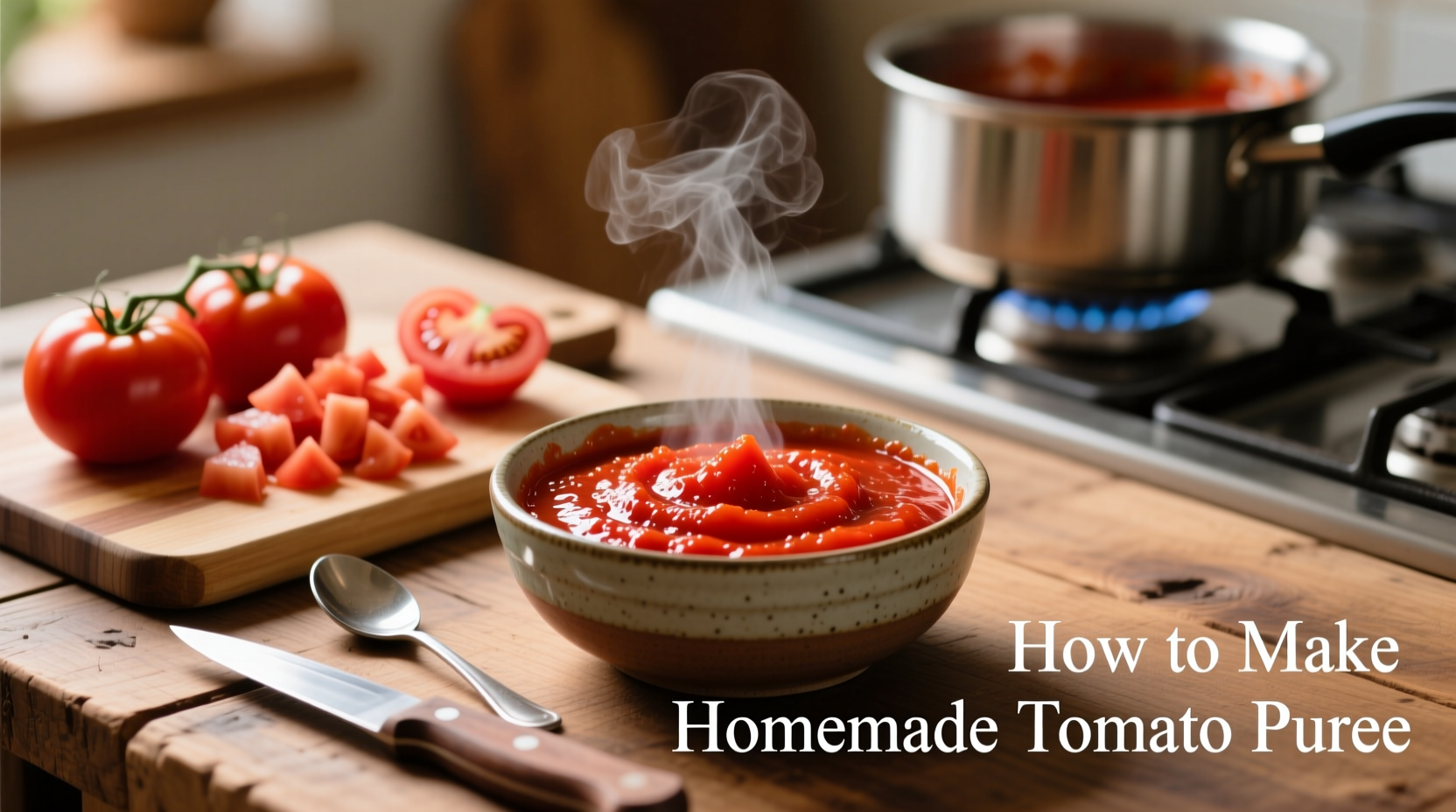Make perfect homemade tomato puree in just 3 steps: 1) Blanch ripe tomatoes for 30 seconds, 2) Blend peeled tomatoes until smooth, 3) Simmer for 20 minutes to thicken. No additives needed, ready in under an hour, and lasts 5 days refrigerated or up to 12 months frozen.
Creating vibrant, flavorful tomato puree at home beats store-bought versions in freshness, cost, and versatility. This guide reveals professional techniques for achieving restaurant-quality results with basic kitchen tools. Whether you're preserving summer's bounty or crafting the perfect base for sauces, soups, and stews, our tested method ensures consistent success every time.
Why Homemade Tomato Puree Beats Store-Bought
Commercial tomato purees often contain preservatives, citric acid, and calcium chloride to extend shelf life and maintain color. When you make your own, you control the ingredients and capture peak-season flavor. According to USDA Food Safety and Inspection Service guidelines, homemade puree without additives requires proper acidification (pH below 4.6) for safe canning - something most commercial products already address through processing.
| Characteristic | Homemade Puree | Store-Bought Puree |
|---|---|---|
| Ingredients | Tomatoes only (optional salt) | Tomatoes, citric acid, calcium chloride, preservatives |
| Flavor Profile | Bright, fresh, customizable | Consistent but often metallic or processed |
| Cost per Quart | $1.50-$3.00 (seasonal) | $3.50-$6.00 |
| Shelf Life (unopened) | 12 months frozen, 18 months canned | 24 months |
Selecting the Perfect Tomatoes
Your puree is only as good as your starting ingredients. For optimal results:
- Roma (plum) tomatoes contain less water and more flesh, yielding thicker puree with less cooking time
- Variety matters: San Marzano varieties offer sweeter flavor with lower acidity
- Ripeness is critical: Choose deeply colored, firm-but-yielding tomatoes with no green shoulders
- Avoid refrigeration before processing - cold temperatures degrade flavor compounds
According to research from the University of California Agriculture and Natural Resources, vine-ripened tomatoes contain up to 30% more lycopene than grocery store varieties harvested green and ripened artificially.

Essential Equipment Checklist
You don't need specialized gear, but these tools make the process efficient:
- Large stock pot (for blanching and simmering)
- Immersion blender or regular blender (food mill optional for ultra-smooth texture)
- Slotted spoon and ice bath setup
- Storage containers (glass jars for refrigeration/freezing, canning jars for shelf-stable)
Step-by-Step Preparation Guide
Step 1: Blanch and Peel (10 minutes)
- Score an "X" on the bottom of each tomato
- Submerge in boiling water for exactly 30 seconds
- Transfer immediately to ice bath for 2 minutes
- Peel starting from the "X" - skins should slip off easily
Step 2: Blend to Desired Consistency (5 minutes)
- Place peeled tomatoes in blender (no need to remove seeds)
- Pulse until smooth (15-20 seconds)
- For smoother texture, press through food mill to remove seeds/skins
Step 3: Simmer and Thicken (20-40 minutes)
- Pour blended tomatoes into stock pot
- Simmer uncovered over medium-low heat
- Stir every 5 minutes to prevent scorching
- Cook until reduced by 25% (thick enough to coat the back of a spoon)
- Optional: Add 1 tablespoon lemon juice per quart for safe canning
Storage Solutions for Every Need
Preserve your harvest properly with these science-backed methods:
Refrigeration (5-7 days)
Store in airtight glass containers with 1/2 inch headspace. The National Center for Home Food Preservation confirms that properly acidified puree (pH ≤ 4.6) remains safe for one week refrigerated.
Freezing (10-12 months)
Pour cooled puree into ice cube trays, then transfer frozen cubes to labeled freezer bags. This portion-controlled method lets you thaw exactly what you need.
Canning (18-24 months)
Process pints for 35 minutes or quarts for 40 minutes in a boiling water bath. Always follow USDA Complete Guide to Home Canning (2015) for current safety standards.
Troubleshooting Common Issues
Problem: Puree is too watery
Solution: Continue simmering uncovered while stirring frequently. For immediate thickening, add 1 teaspoon cornstarch mixed with 1 tablespoon cold water per cup of puree.
Problem: Separation during storage
Solution: This natural occurrence happens with all tomato products. Simply stir before using - no need for emulsifiers.
Problem: Metallic taste
Solution: Avoid aluminum cookware. Use stainless steel, enameled cast iron, or glass for all processing steps.
Culinary Applications Beyond Basic Sauce
Transform your puree into these professional dishes:
- Concentrated tomato base: Reduce further to create tomato paste substitute
- Vibrant salad dressings: Mix with olive oil, garlic, and herbs
- Flavorful braising liquid: Use instead of stock for meats and vegetables
- Infused oils: Simmer with herbs for flavored oil base
- Healthy ketchup alternative: Simmer with apple cider vinegar and spices
Seasonal Adaptation Guide
Adjust your technique based on tomato quality throughout the year:
- Peak season (July-Sept): Use minimal cooking - fresh flavor shines
- Off-season: Add 1/4 cup roasted red peppers per quart for depth
- Green tomatoes: Substitute 25% with sweet peppers for balanced acidity
Frequently Asked Questions
Find quick answers to common concerns about making and using homemade tomato puree.











 浙公网安备
33010002000092号
浙公网安备
33010002000092号 浙B2-20120091-4
浙B2-20120091-4